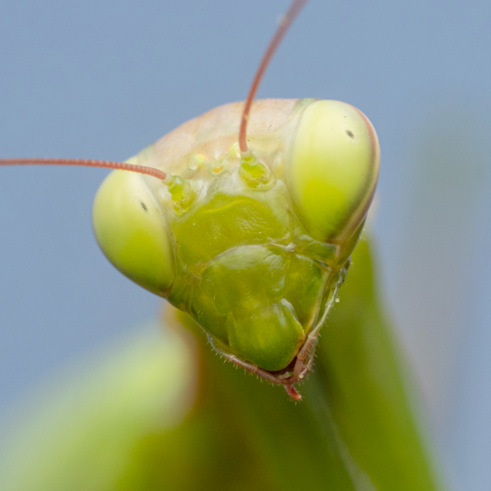What's that bug: Identifying the praying mantids of Michigan
Learn more about the two species of praying mantis found in Michigan and when you can easily spot them.

Praying mantis, known plurally as mantids, are an order (Mantodea) of predatory insects named for their unique forelimbs which resemble a praying position. They can be found worldwide. Historically, Michigan had no native species of praying mantis but over the past few centuries, two species have been introduced: the Chinese mantis (Tenodera sinensis) and the European mantis (Mantis religiosa). Both species are commonly seen during their breeding season from late summer to early fall. Praying mantis have no known significant ecological impacts in Michigan; however, there is continued debate and ongoing research on this topic. Still, they likely do not make the best garden pest manager as they are known to eat both good and bad insects in home gardens.

How do you distinguish between them? Fortunately, identifying each species is quite simple. Chinese mantids tend to be larger than European mantids and are usually brown in color with a line of green along the wings in mature adults while European mantises are typically green.

For both species, males have more uniformly sized abdominal segments (usually eight) or divisions along the rear end, or abdomen, of the mantis. Females have fewer (usually six) abdominal segments that are not all similarly sized. However, it is hard to count abdominal segments until the mantids have molted, a process shared among many insects where they shed their durable exoskeleton to continue growing. The number of molts, or instars, a mantis undergoes before it fully matures as a winged adult depends on the species. Each molt they get a little bigger until they reach adulthood for breeding.
Although mantids occupy Michigan all year, Michigan State University Extension recognizes that they are most noticed during their mating season (August – October). This is because male mantids use their newly developed wings to fly in search of females. While females also develop wings, they do not fly as frequently. You are likely to see them on windows or outdoor structures, especially near lights which attract smaller flying insects, the perfect mantid dinner. When it’s not breeding season, mantids spend most of their life cycle hiding closer to the ground and among plant stems.
During the breeding season, females will lay an egg case, called an ootheca, with 50-200 eggs inside (the number varies by species and by the health condition of the female). These ootheca protect the eggs inside through the winter until the spring when the newly hatched mantids, known as nymphs, emerge as tiny, wingless versions of their adult-selves. They will molt several times throughout the spring and summer until they become fully mature in late summer and the cycle repeats again. If you see a mantis without fully developed wings, it’s not an adult yet.
Did you know it is not actually true that all female mantids will eat their mates? Mantids only consume their mates if they are in poor body condition because it will improve the chances of their offspring surviving. If a female mantis is well-fed, she will not eat her mate.

Mantids are famous for their sit-and-wait (otherwise known as ambush) predatory style. They typically stay very still in one place and wait for food to come to them. And they are very good at camouflaging to trick their prey into coming close enough to snatch. They will try to eat anything they can catch, even if it’s as big as they are!
Even though mantids eat beneficial insects (and sometimes, though rarely, very small birds like hummingbirds) they have not been found to cause significant economic or ecological harm in the ecosystems they inhabit. In addition, both species have been present in Michigan for over 100 years and have adapted to the Michigan ecosystem. Therefore, mantids in Michigan are generally considered non-native rather than invasive.



 Print
Print Email
Email

